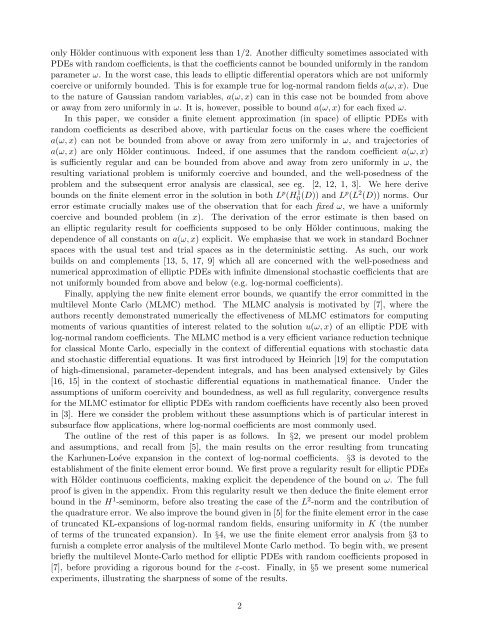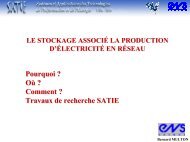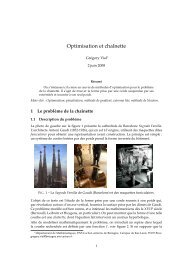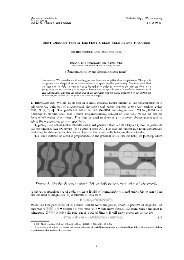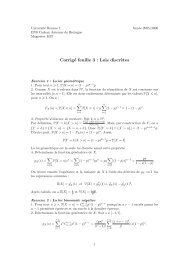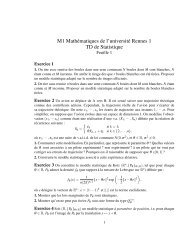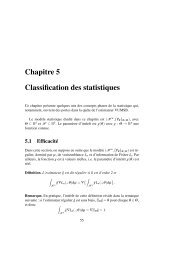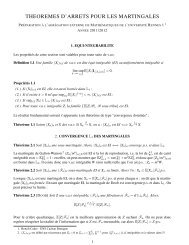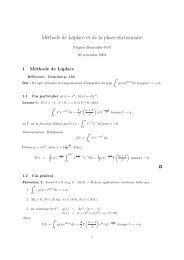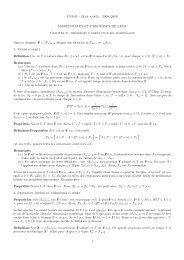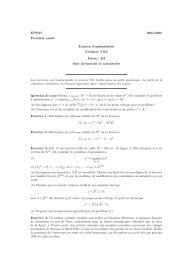Bath Institute For Complex Systems - ENS de Cachan - Antenne de ...
Bath Institute For Complex Systems - ENS de Cachan - Antenne de ...
Bath Institute For Complex Systems - ENS de Cachan - Antenne de ...
Create successful ePaper yourself
Turn your PDF publications into a flip-book with our unique Google optimized e-Paper software.
only Höl<strong>de</strong>r continuous with exponent less than 1/2. Another difficulty sometimes associated withPDEs with random coefficients, is that the coefficients cannot be boun<strong>de</strong>d uniformly in the randomparameter ω. In the worst case, this leads to elliptic differential operators which are not uniformlycoercive or uniformly boun<strong>de</strong>d. This is for example true for log-normal random fields a(ω, x). Dueto the nature of Gaussian random variables, a(ω, x) can in this case not be boun<strong>de</strong>d from aboveor away from zero uniformly in ω. It is, however, possible to bound a(ω, x) for each fixed ω.In this paper, we consi<strong>de</strong>r a finite element approximation (in space) of elliptic PDEs withrandom coefficients as <strong>de</strong>scribed above, with particular focus on the cases where the coefficienta(ω, x) can not be boun<strong>de</strong>d from above or away from zero uniformly in ω, and trajectories ofa(ω, x) are only Höl<strong>de</strong>r continuous. In<strong>de</strong>ed, if one assumes that the random coefficient a(ω, x)is sufficiently regular and can be boun<strong>de</strong>d from above and away from zero uniformly in ω, theresulting variational problem is uniformly coercive and boun<strong>de</strong>d, and the well-posedness of theproblem and the subsequent error analysis are classical, see eg. [2, 12, 1, 3]. We here <strong>de</strong>rivebounds on the finite element error in the solution in both L p (H0 1(D)) and Lp (L 2 (D)) norms. Ourerror estimate crucially makes use of the observation that for each fixed ω, we have a uniformlycoercive and boun<strong>de</strong>d problem (in x). The <strong>de</strong>rivation of the error estimate is then based onan elliptic regularity result for coefficients supposed to be only Höl<strong>de</strong>r continuous, making the<strong>de</strong>pen<strong>de</strong>nce of all constants on a(ω, x) explicit. We emphasise that we work in standard Bochnerspaces with the usual test and trial spaces as in the <strong>de</strong>terministic setting. As such, our workbuilds on and complements [13, 5, 17, 9] which all are concerned with the well-posedness andnumerical approximation of elliptic PDEs with infinite dimensional stochastic coefficients that arenot uniformly boun<strong>de</strong>d from above and below (e.g. log-normal coefficients).Finally, applying the new finite element error bounds, we quantify the error committed in themultilevel Monte Carlo (MLMC) method. The MLMC analysis is motivated by [7], where theauthors recently <strong>de</strong>monstrated numerically the effectiveness of MLMC estimators for computingmoments of various quantities of interest related to the solution u(ω, x) of an elliptic PDE withlog-normal random coefficients. The MLMC method is a very efficient variance reduction techniquefor classical Monte Carlo, especially in the context of differential equations with stochastic dataand stochastic differential equations. It was first introduced by Heinrich [19] for the computationof high-dimensional, parameter-<strong>de</strong>pen<strong>de</strong>nt integrals, and has been analysed extensively by Giles[16, 15] in the context of stochastic differential equations in mathematical finance. Un<strong>de</strong>r theassumptions of uniform coercivity and boun<strong>de</strong>dness, as well as full regularity, convergence resultsfor the MLMC estimator for elliptic PDEs with random coefficients have recently also been provedin [3]. Here we consi<strong>de</strong>r the problem without these assumptions which is of particular interest insubsurface flow applications, where log-normal coefficients are most commonly used.The outline of the rest of this paper is as follows. In §2, we present our mo<strong>de</strong>l problemand assumptions, and recall from [5], the main results on the error resulting from truncatingthe Karhunen-Loéve expansion in the context of log-normal coefficients. §3 is <strong>de</strong>voted to theestablishment of the finite element error bound. We first prove a regularity result for elliptic PDEswith Höl<strong>de</strong>r continuous coefficients, making explicit the <strong>de</strong>pen<strong>de</strong>nce of the bound on ω. The fullproof is given in the appendix. From this regularity result we then <strong>de</strong>duce the finite element errorbound in the H 1 -seminorm, before also treating the case of the L 2 -norm and the contribution ofthe quadrature error. We also improve the bound given in [5] for the finite element error in the caseof truncated KL-expansions of log-normal random fields, ensuring uniformity in K (the numberof terms of the truncated expansion). In §4, we use the finite element error analysis from §3 tofurnish a complete error analysis of the multilevel Monte Carlo method. To begin with, we presentbriefly the multilevel Monte-Carlo method for elliptic PDEs with random coefficients proposed in[7], before providing a rigorous bound for the ε-cost. Finally, in §5 we present some numericalexperiments, illustrating the sharpness of some of the results.2


